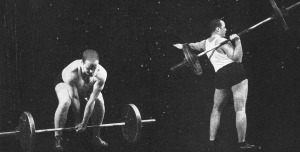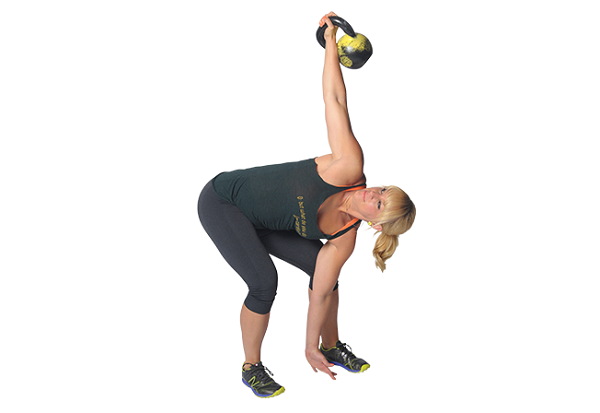
The history of the bent press dates back to the time of the great Eugene Sandow, who popularized it in the late 1980s. He learned this exercise from Professor Attila.
However, others claim that it became popular even before Sandow. Richard Penel practiced it before Sandow in the United States, and so did the McKen brothers, but Sandow was the man who really made her famous among English-speaking athletes. The bent press was a mania for weightlifters from the 1990s to the First World War.
The bent press was not popular with continental weightlifters. Most of them were too massive to perform it and could not bend far enough or sideways to make a good lift in this style. They also thought that the bent press was a trick rather than a lift, but that didn’t stop them from practicing.
There were men who were able to lift much more with one hand in a bent-style style than with two hands in other styles. A good example of this is Bob Hoffman (the founder of York) with his 66 kg military press and his 113 kg bent press.
Contraindications
In case you want to include the bent press in your workout, it is good to know that:
- the technique is for intermediate and advanced trainees;
- requires high mobility and stretch;
- does not tolerate weak muscle groups in the chain of dynamists, synergists and stabilizers;
- its poor performance carries a real risk of injury;
- requires that you have no injuries in: wrists, elbows, shoulders, shoulder girdle, spine, pelvis (with straight legs) and additionally healthy knees and ankles (squat technique).
- if you have spinal deformities, do not use the technique without first consulting a physiotherapist.
Participating muscles
As a complex, multi-joint movement we see a whole palette of participating muscle groups. The role of all of them varies from technique to technique.
Major dynamists
- Middle shoulder heads – Deltoid lateral
- Triceps – Triceps brachii
- Oblique abdominal muscles – Obeliques
- Deep dorsal lateral flexors – Quadratus lumborum
- Long spinal muscles – Erector spinae
- Posterior thigh muscles – Biceps femoris, Semitendinosus, Semimembranosus
- Quadriceps – Quadriceps femoris (in squat technique)
- Buttock muscles – Gluteus maximus (in squat technique)
Synergists
- Anterior shoulder heads – Deltoid anterior
- Supraspinatus – Supraspinatus
- Trapezius muscle (middle and lower sector) – Trapezius middle & lower
- Seratus (lower sector) – Serratus anterior
- Large pectoral muscles (upper heads) – Pectoralis major, Clavicular
- Hip contractors – Iliopsoas
Dynamic stabilizers and stabilizers
- Triceps (long head) – Triceps brachii, long head
- Biceps – Biceps brachii
- Quadriceps – Quadriceps femoris (in the technique of bending with straight legs)
- Buttock muscles – Gluteus maximus (in the technique of bending with straight legs)
- Trapezius muscle (all heads) – Trapezius Upper, Lower & Middle
- Levator scapulae
- Small back muscles – Teres minor, Teres major
- Broad back muscles – Latissimus dorsi
- Adductors of the thighs – Adductors
Variants according to the technique
- Classic – with bending and twisting diagonally between the legs (Hoffman);
- By leaning sideways and forward (Saxon);
- With deep bending between the legs, deep squat and straightening (Gasnier);
- Deeply extended back elbow, perpendicular to the leading leg (Matisek) and others.
Options according to the weight used
- With a barbell – a very difficult option, requires extra effort in the forearm muscles;
- With dumbbell – classic version;
- With pudovka – another classic option, but with an easier balance.
Bob Hoffman shows the proper performance of the bent press:
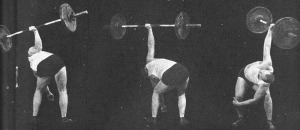
Arthur Saxon, one of the world’s greatest lifters from the past, set a record in the bent press with 168 kg at a personal weight of 95 kg. This photo shows Saxon already pushing the barbell with one hand. He didn’t practice the standard style of twisting the bent press, he just leaned slightly to the side before pushing began, then leaned forward and pushed the weight over his head.
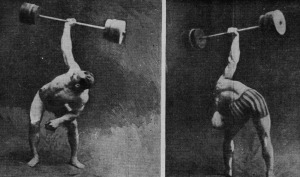
Pierre Gassnier, a small but great strongman from France, shows the lower position of the bent press when the arm is already straight. Some good pushers like Arthur Saxon kept their other hand on the knee on the same side. But the majority then preferred to keep their shoulder between their knees and the other hand on the opposite leg. This style allows the body to lean forward by at least another 15 cm, which facilitates heavy pushing. From this position, the athlete goes into a full squat, then, balancing the weight, stands up. Once upright, he puts his feet in a straight line, holding the weight for at least two seconds, thus achieving a perfect bent press. Gasnier had tremendous strength, even though he was in the lightweight category, he could break metal chains, which was really amazing. The dumbbell he pushes in the photo weighed 107 kg.
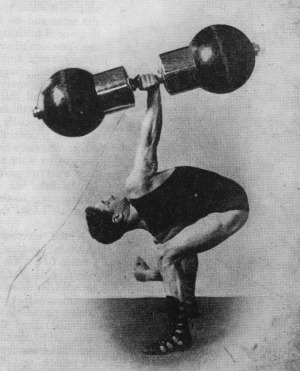
Anton Matisek is considered one of the strongest and most well-developed men in the past. He worked for the Baltimore Police and was a physical education teacher at the same organization. This photo was taken at a professional power show, it shows athlete Anton Matisek preparing to push the weight up. You will notice that the lever is almost parallel to the shoulder, the elbow is leaning close to the hips and well back, the leg on the pushing side is in a perpendicular line with the forearm. This style of bent press is quite difficult, especially with such weight.
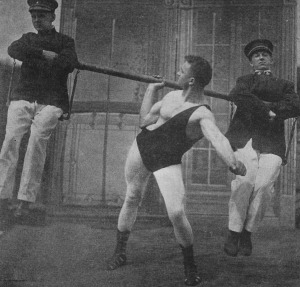
John Smith shows his perfect form in the bent press. He was one of the greatest dam presses in history. The photo was taken in 1900-1901, and the dumbbell weighed 84 kg. Smith was able to forcefully turn the dumbbell and do 3 repetitions in the style of a bent press. Notice how the right side of the latissimus dorsi muscle and the right side of the trapezius muscle are contracted into a compact mass on which the right arm rests.
Al Baynart from Detroit Michigan, record holder in the bent press with 150 kg.
Bent press is quite a difficult and complex exercise. You must learn the perfect form of performance before trying to lift a lot of weight.
The old adage “Perfect happens with practice” is good, but there is also a serious dose of untruth in it – for example, if you started with the bent press, but with the wrong technique, you can lift quite a lot of weight, but with this wrong style you prove that with practice you have perfected your mistakes.
But a person who first learns the right technique will eventually lift a much heavier weight over his head.
Classic bent press
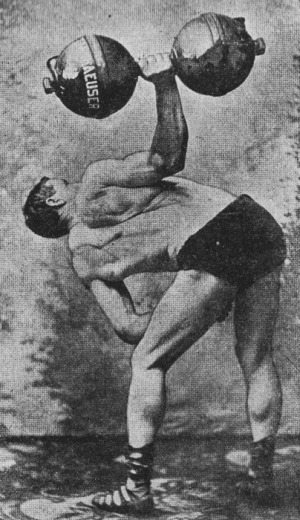
Preparation
- The two images above show Bob Hoffman performing the various phases of the bent press. First you hold the lever in the middle with both hands, the lifting arm is placed in the correct position, and the other is above it, with it you help to raise the lever to your shoulder. The elbow is placed comfortably back near the hips, then the legs should be placed in the correct position. There is no set exact position of the legs in this case as is convenient for the athlete.
- It is good for the leg and the lifting arm to be in a perpendicular position so that you have more support while lifting the weight (you will see this in the photo of Bob Hoffman in the second phase and in the photo of Anton Matisek).
- This whole moment of lifting the weight from the floor to its correct positioning must be done as quickly as possible, after which the ejection begins. Saxon says the strength of the arm weakens as you lift the weight to your shoulder.
- The elbow is raised and the pelvis is brought back slightly, the toes of the opposite foot pointing outwards in the same position in which the body will bend.
Execution
- Always watch the weight, leaning forward and sideways while still keeping your elbow close to your hips.
- Keep your forearm perpendicular, gently directing the weight back as you continue to fight it. Now the arm is ready to stand up: here the athlete must try with all his might to push the weight. When the arm is almost straight, the supporting leg, which has been upright so far, bends.
- Continue to bend both knees, applying pressure against the weight and gradually straighten the arm. When you reach the point where the hand is “locked”, you should be in a similar position as in phase 4 and 5 of the second photo of Bob Hoffman or as in the photo of Gasnier.
- When the thighs are horizontal, you move into a full squat position, moving the weight slightly back so that the body is just below it. With this movement you distribute the tension on both legs.
- The other arm plays an important role in maintaining the torso when the shoulder is against the upper thigh or knee while the arm is on the opposite leg. But now she has to assist in pushing against your legs, helping you to stand up.
Comments and recommendations
- Most beginners make the mistake right at the moment of bending, when they decide to push the weight away from their hips, when theoretically there should be no push until the body is bent enough and the arm is almost in a locked position. Pushing should begin when your torso is almost at right angles to your legs. He is best seen in the third and fourth positions in the second photo with Hoffman.
- Here (at the bottom) again, many beginners make the mistake of trying to get up immediately from this position.
- There are several important things that should always be in the head of every athlete while performing the bent press: always watch the weight and in any case the forearm should remain perpendicular throughout the lift.
- The greater the weight, the more the elbow should remain on the hips. But there is another thing – people with larger (muscular) hands like Hoffman and Saxon can not touch their hips with their elbows while bending and turning, so they use as a support the “latissimus” on which the armpit is leaned (note the photo of John Smith).
- Remember, the speed of the lift is guided by the balance of weight you have achieved. If you rush to push, you may lose balance and lose weight. Another important point is not to allow the weight to swing or move as you push it up. Always start the lift with a lever (handle) that is parallel to the back, not at a right angle (note the photo of Matisek).
The main principle behind the bent press is to keep the weight at a level that twists the body under it.
In order to perform the heavy weight bent press properly, you need to be really strong and have more mobility.
This is an incredible lift in which real men and athletes once showed their strength and abilities. It is no coincidence that the bent press is the queen of exercise.
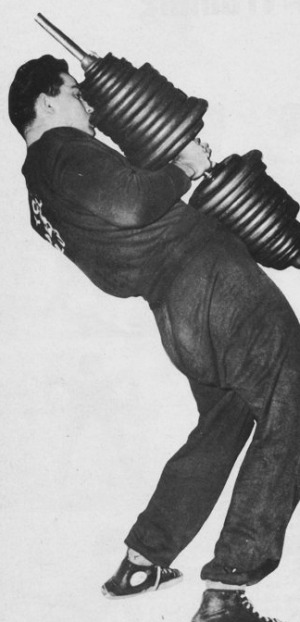
Fitness and fitness training
Fitness and fitness trainers can use the dumbbell press in their fitness training schemes. This applies to both men and women. To gentlemen, the bent press offers a stronger and more stable torso. For ladies – a thin, tight waist and straight shoulders, in other words – a better posture.
Strength and strength training
Those who practice this lift can achieve quite a lot of strength. The good side of the bent press is that it both develops the muscles of the body in various ways (both pushing and pulling in one movement), and it is a kind of strength test for the balances: pushing-pulling and left / right side of the body muscles.
Fitness bodybuilding
Those who train according to the classic bodybuilding schemes will hardly benefit from the vision of the specific movement. Among other things, it will bring more risks than benefits to them.
Crossfit
The bent press is not among the most popular movements in crossfit. You can include it in power circuits at your discretion.
Street fitness
Pudovka is the only chance for the street trainer to include a bent press in his training. Since the wearers who carry pudovki in their trunks in our country are mostly coaches, the conclusion is that the equipment does not have a great future in school grounds.

